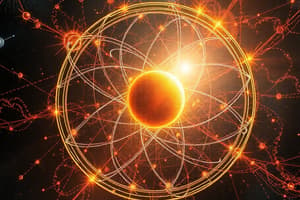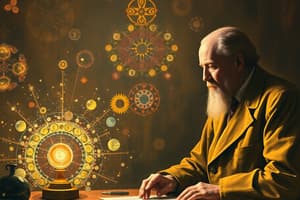Podcast
Questions and Answers
What was a primary conclusion drawn from Rutherford's experiments with positively charged particles?
What was a primary conclusion drawn from Rutherford's experiments with positively charged particles?
- Atoms consist predominantly of empty space. (correct)
- Electrons are located in fixed orbits around the nucleus.
- The nucleus contains both protons and electrons.
- Atoms have equal numbers of protons and electrons.
How did Rutherford's atomic model visualize the interactions between charged particles?
How did Rutherford's atomic model visualize the interactions between charged particles?
- As a series of waves passing through a medium.
- Similar to a ball hitting a rigid object in a pinball machine. (correct)
- Like celestial bodies in a gravitational field.
- As particles colliding with a fluid substance.
What role does the nucleus play in Rutherford's atomic model?
What role does the nucleus play in Rutherford's atomic model?
- It holds electrons in fixed orbits around itself.
- It houses a small, dense collection of positive charge. (correct)
- It is the only component where chemical reactions occur.
- It contains negatively charged particles, preventing stability.
In what year did Ernest Rutherford make his significant declaration regarding atomic models?
In what year did Ernest Rutherford make his significant declaration regarding atomic models?
What did Rutherford observe when he fired positively charged particles at a thin layer of atoms?
What did Rutherford observe when he fired positively charged particles at a thin layer of atoms?
What significant contribution did Rutherford make to the concept of atomic structure in 1911?
What significant contribution did Rutherford make to the concept of atomic structure in 1911?
Which radiation types did Rutherford identify in his 1899 publication?
Which radiation types did Rutherford identify in his 1899 publication?
What was the outcome of Rutherford's experiment that involved alpha particles and nitrogen atoms?
What was the outcome of Rutherford's experiment that involved alpha particles and nitrogen atoms?
What personal achievement surprised Rutherford, according to his own statement?
What personal achievement surprised Rutherford, according to his own statement?
Which of the following best describes the characteristic of the alpha particles identified by Rutherford?
Which of the following best describes the characteristic of the alpha particles identified by Rutherford?
What prior discovery influenced Rutherford's research into radioactivity?
What prior discovery influenced Rutherford's research into radioactivity?
What was notable about Rutherford's early academic achievements?
What was notable about Rutherford's early academic achievements?
How did Rutherford's findings about atomic structure challenge previous scientific views?
How did Rutherford's findings about atomic structure challenge previous scientific views?
What does Rutherford imply about the traditional view of the atom?
What does Rutherford imply about the traditional view of the atom?
Which statement best reflects Rutherford's upbringing regarding atoms?
Which statement best reflects Rutherford's upbringing regarding atoms?
What aspect of atomic theory does Rutherford challenge in his statement?
What aspect of atomic theory does Rutherford challenge in his statement?
What year did Rutherford deliver the address regarding his views on atoms?
What year did Rutherford deliver the address regarding his views on atoms?
In what context did Rutherford make his statement about atoms?
In what context did Rutherford make his statement about atoms?
What is a key aspect of Rutherford's model of the atom?
What is a key aspect of Rutherford's model of the atom?
Which concept did Bohr introduce to explain electron behavior in atoms?
Which concept did Bohr introduce to explain electron behavior in atoms?
What did Rutherford conclude about hydrogen nuclei during his experiments?
What did Rutherford conclude about hydrogen nuclei during his experiments?
How does the concept of half-lives apply to radioactive materials?
How does the concept of half-lives apply to radioactive materials?
What did Thomson's 'plum pudding' model of the atom propose?
What did Thomson's 'plum pudding' model of the atom propose?
What significant discovery did Rutherford's experiments lead to in 1932?
What significant discovery did Rutherford's experiments lead to in 1932?
What major error did scientists need to correct in earlier atomic models after Rutherford's experiments?
What major error did scientists need to correct in earlier atomic models after Rutherford's experiments?
What element was named in honor of Rutherford for his contributions to atomic science?
What element was named in honor of Rutherford for his contributions to atomic science?
Flashcards are hidden until you start studying
Study Notes
Ernest Rutherford's Life and Work
- Ernest Rutherford was born in New Zealand and studied at Cambridge University with J.J. Thomson.
- Rutherford's work at McGill University in Montreal led to his winning the Nobel Prize in Chemistry for his investigations into the disintegration of elements.
- Rutherford was the first to discover alpha and beta radiation.
- Rutherford proposed the "Rutherford model" of the atom, which suggests a small, dense, positively charged nucleus surrounded by orbiting electrons.
Key Discoveries and Contributions
- Rutherford's experiments led to the discovery of the atomic nucleus, which contradicted the "plum pudding" model of the atom.
- His experiments also helped to discover the proton, the positively charged particle in the nucleus.
- Rutherford's work led to the creation of the first synthetic element, Rutherfordium, named in his honor.
Rutherford's Atomic Model
- Rutherford's atomic model, sometimes called the "planetary model," describes the atom as having a tiny, dense, positively charged nucleus at the center, orbited by negatively charged electrons.
- The model is often compared to a miniature solar system, with the nucleus acting like the Sun and the electrons acting like planets.
- Rutherford's model was a significant advancement in understanding the atom's structure.
Rutherford's Experiment
- Rutherford's team fired alpha particles at a thin gold foil.
- Most particles passed straight through the foil, but some were deflected, and a few bounced back.
- This experiment led Rutherford to conclude that the atom is mostly empty space with a small, dense, positively charged nucleus at the center.
Bohr's Contributions to Atomic Structure
- Niels Bohr, a Danish physicist, used quantum physics to explain the structure of the atom.
- Bohr proposed that electrons have fixed energy levels and orbit the nucleus at specific distances, in distinct "shells."
- Electrons can change energy levels by absorbing or emitting packets of energy (quanta).
Discovery of the Nucleus and the Proton
- Rutherford discovered that when he bombarded light elements with alpha particles, hydrogen nuclei were emitted.
- He concluded that hydrogen nuclei were the building blocks of the atom and named the positively charged particle in the hydrogen nucleus the proton.
Transmutation
- Rutherford achieved the first transmutation of elements by using equipment to turn nitrogen atoms into oxygen atoms through collisions with alpha particles.
- He observed the protons inside the equipment via a window.
Early Models of the Atom
- Before Rutherford's work, scientists believed that atoms were indivisible.
- Early models, like the "plum pudding" model, proposed that atoms were a diffuse cloud of positive charge with electrons embedded within it.
- Scientists were also aware that radioactive materials disintegrate at different rates, known as "half-lives."
Studying That Suits You
Use AI to generate personalized quizzes and flashcards to suit your learning preferences.





